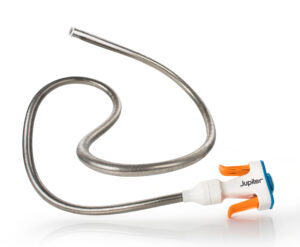
Jupiter Endovascular has closed a series B financing round, surpassing its US$40 million target, with proceeds to be used to complete the ongoing SPIRARE II pivotal clinical trial, prepare for commercialisation, and develop new clinical applications for its Transforming Fixation (TFX) platform technology.
The financing comes between two major milestones; US Food and Drug Administration (FDA) 510(k) clearance last month of the Vertex catheter incorporating TFX, and the upcoming presentation of first-in-human results for the Vertex pulmonary embolectomy system with TFX from the SPIRARE I trial at the 2025 TCT meeting (25–28 October, San Francisco, USA).
The round was led by Sonder Capital, with participation from Senvest Management, LB Investment, and a new strategic corporate investor.
“Closing this oversubscribed series B financing round reflects strong conviction in our mission to rewrite the rules of endovascular medicine using TFX technology,” said Carl J St Bernard, chief executive officer of Jupiter Endovascular. “We’re energised by the support of this distinguished syndicate of investors as we tackle one of the greatest unmet needs in transcatheter interventions—the lack of stability and control physicians face while operating in complex cardiovascular anatomies—starting with pulmonary embolism.”
SPIRARE I is a prospective, single-arm, multicentre study which enrolled 10 subjects with acute, intermediate-risk pulmonary embolism (PE) treated with the Vertex pulmonary embolectomy system at two sites in Europe. The results from SPIRARE I will be presented at the TCT 2025 meeting by Irene Lang (Medical University of Vienna, Vienna, Austria), the trial’s principal Investigator.
The company is also currently enrolling patients in SPIRARE II, a prospective, single-arm, multicentre pivotal trial which will enrol up to 145 patients with acute, intermediate-risk PE treated with the Vertex pulmonary embolectomy system at up to 25 sites in the USA and Europe.
Trial endpoints for both SPIRARE I and SPIRARE II will characterise the procedural and clinical benefits of PE treatment with TFX using the Vertex system, across measures of safety, right heart function, and clinical improvement from the time of the procedure to 30 days post-procedure.
The company’s TFX platform technology, integrated into the Vertex system, is designed to bring stability and control to a variety of catheter interventions while protecting the cardiovascular anatomy, with the goal of enabling interventionalists to treat anatomical sites that are not safely or easily accessible via conventional endovascular approaches.
The Vertex device is delivered in a flexible, relaxed state over a guidewire to a target location in the vasculature, rapidly pressurised with saline to fix it in a stable position for intervention, then returned to its relaxed state to navigate to another target location or for removal.
“Since the earliest days of endovascular medicine, the inability to maintain catheter control has been the single greatest barrier to the wider adoption of transcatheter therapies,” said Deborah Kilpatrick, partner at Sonder Capital. “Jupiter is addressing this vast unmet need with a revolutionary advance that can provide stability in even the most tortuous anatomies, unlocking new possibilities for the millions of patients who are being underserved with today’s intravascular approaches. We are proud to lead this round and to partner with Carl and the Jupiter team to bring this technological breakthrough to physicians and patients worldwide.”










